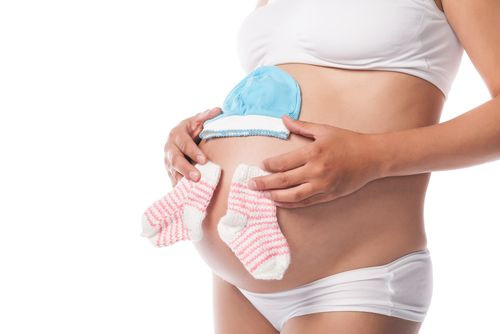What To Expect When You're Expecting: 7 Pregnancy Myths Busted For A Smooth 9 Months

The next nine months leading up to labor is critical for an expecting mother and her baby. During the first, second, and third trimester, a woman will experience hormonal and physiological changes that will affect her child, and her physical and emotional being. It is likely while pregnant, moms-to-be will hear a lot of old wives’ tales, myths, and superstition, including those that may pose severe health complications for the mother and baby. To prevent any ludicrous lore and legend affecting your baby bump, we have examined and dispelled the seven most common pregnancy myths, and why they may not happen to you.
Myth #1: Pregnant women crave pickles and ice cream.
False: Although some women tend to develop a preference for pickles and ice cream, not all expectant mothers have these particular food cravings. Rather, junk food cravings such as these suggest the body needs certain vitamins and minerals that are commonly diluted during pregnancy. Dr. Phil McGraw, psychologist and American television personality, with the help of Yfat Reiss, co-author of How to Make a Pregnant Woman Happy, explained women who desire foods such as pickles have a craving for salt and may be mineral deficient, specifically sodium deficient. The supplementation of minerals are essential during pregnancy, since women’s bodies increase blood volume by up to 20 percent, meaning the existing minerals are diluted.
Myth #2: Pregnant women shouldn’t eat fish.
False: It is recommended women eat fish due to its high content of omega-3 fatty acids like docosahexaenoic acid (DHA), which actually help to enhance the development of the baby’s brain, boost IQ, and sleep better, according to March of Dimes. This could prevent premature contractions and labor, high blood pressure during pregnancy, and could even act as an anti-inflammatory agent to prevent infection for the mother. Expectant mothers can eat up to 12 ounces of fish per week, including salmon, herring, sardines, and fresh-water trout, while they can eat up to 6 ounces per week of albacore (white) tuna.
Moreover, women can also eat sushi, except for mackerel, shark, tilefish, and swordfish. These fish have high levels of mercury content, says the U.S. Environmental Protection Agency, that may harm an unborn baby, or young child’s developing nervous system. Pregnant women should eat fish and shellfish that are lower in mercury.
Myth #3: Women should abstain from alcohol during pregnancy.
Maybe: When a pregnant woman consumes alcohol during her pregnancy, so does her baby because the drug passes through the placenta to the baby. This increases the risk that the baby will be born with a Fetal Alcohol Spectrum Disorder (FASD), says the American Pregnancy Association, which leads physical, mental, and neurobehavioral birth defects. The American College of Obstetricians and Gynecologists (ACOG) suggests women avoid alcohol entirely while pregnant or trying to conceive because of the potential damage it may cause.
There exists conflicting research that suggests occasional light drinking during pregnancy is unlikely to harm the baby. A recent study published in the journal Alcohol and Alcoholism found moderate drinking may lead to better mental health than children of mothers who abstain from alcohol. However, the problem with drinking alcohol during pregnancy is there is no amount that has been proven to be safe.
Myth #4: Women should eat for two while pregnant.
False: Expectant moms are under the false pretense that because they’re pregnant they have to eat for two, but in reality, carrying a baby only requires 200 to 300 extra calories a day. The Cleveland Clinic says these calories should come from nutrient-dense foods such as lean meats, low fat dairy, fruits, vegetables, and whole grain products, consuming less sweets and treats. A woman who is of average weight before pregnancy can expect to gain 15 to 35 pounds during the pregnancy.
While recommendations may also differ whether the mom is underweight or overweight when they get pregnant, it’s important to remember women only lose between 10 to 15 pounds during delivery. It may take a year or more for moms to lose the rest. However, breastfeeding can help speed the process along, burning up to 500 calories a day.
Myth #5: All pregnant women have morning sickness. If they don’t, that means it’s a boy.
False: A popular gender pregnancy myth surrounding morning sickness is if women don’t have it, it’s a boy. But women and their pregnancy hormone levels are individual and vary. According to the Babycenter.com, morning sickness affects about three quarters of pregnant women during their first trimester, usually starting around six weeks of pregnancy, but it can begin as early as four weeks. It is speculated morning sickness is often due to a rapid rise in the female hormone estrogen during early pregnancy, including other hormones like human chorionic gonadotropin (hCG).
Myth #6: Don’t have sex.
False: Pregnant women may attest to experiencing a spiked interest in sex but often remain confused about whether having sex is safe or not. As long as the pregnancy is proceeding normally, the Mayo Clinic says, women can have sex as often as they like. Typically, sex during pregnancy will not cause a miscarriage, since they are usually related to chromosomal abnormalities or other problems in the developing baby. However, if the placenta is positioned between the cervix and vagina, or if a woman is at high risk for a preterm birth, it’s best to ask the doctor before having sex.
Myth #7: Women who have an STD, will most likely have a baby with an STD, too.
Maybe: This all depends on the STD a woman has. Some STDs infect the blood and can pass through the placenta, while others only pose a threat by direct contact, according to the March of Dimes. About one in four pregnant women is infected with genital herpes, although most do not know it. However, only a small number pass the infection on to their babies.




























